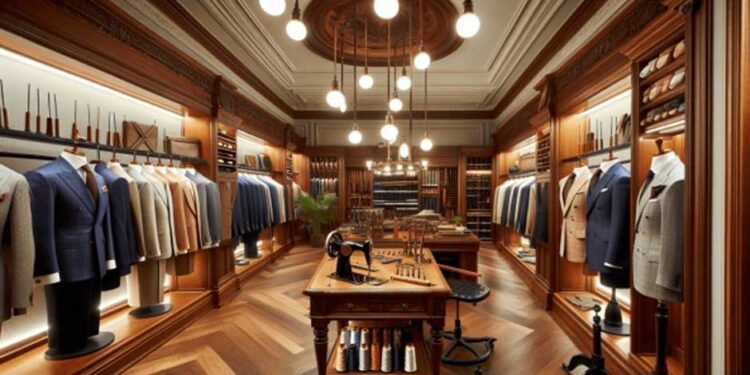Suits have long been a staple in men’s fashion, a symbol of sophistication and professionalism. There are various styles of suits, each with its distinctive characteristics and appeal. The British, American, and Italian suits stand out as the three primary archetypes that have influenced global fashion with their unique flair, craftsmanship, and historical significance. Understanding these differences helps to appreciate the art of tailoring and prelude one’s personal style.
In the world of fashion, suits serve as more than mere attire; they are a statement, an articulation of culture, and a form of personal expression. Whether for business, social events, or ceremonial purposes, a well-tailored suit can uplift an individual’s aura and exude confidence. Considering that, the significance of suits in global fashion is colossal, crossing boundaries and becoming the uniform for the discerning and the driven. Let’s delve into the distinct charm that British, American, and Italian suits bring to the wardrobe.
Characteristics of British Suits
The British suit has a history entrenched in the sartorial splendor of Savile Row, a street in London synonymous with bespoke tailoring and high-quality craftsmanship. British suits carry a cultural weight, symbolizing class and a sense of antiquity. Their iconic status has been burnished by royal endorsements and an association with the British elite, making them a coveted piece of menswear for those who appreciate traditional tailoring.
Design-wise, British suits are known for their structured silhouette, which produces a more formal and stately appearance. The typical British suit features heavier fabrics, like wool and tweed, high armholes, and a nipped waist which allows for a defined chest. This design not only enhances the wearer’s physique but also provides a sharp, tailored look that has been revered for generations. Double vents and thicker lapels are further design traits that add to the suit’s polished and quintessentially British aesthetic.
Characteristics of American Suits
The American suit, often called the “”sack suit,”” has come a long way since its casual and roomier beginnings. Once known for its comfort and utility, it embodies the pragmatic spirit of the American lifestyle. The evolution of the American suit reflects a history of diverse work environments and a preference for less formality in American culture compared to its European counterparts.
Modern American suit design has gradually embraced more form-fitting styles while retaining some of its original hallmarks. Key elements of an American suit typically include a single vent at the back, lower armholes to enhance ease of movement, and a less defined waistline, offering a more relaxed fit. Fabrics tend to be lighter to accommodate the range of climates across the United States, and the suits are suitable for a variety of settings, from business casual to semi-formal events.
Characteristics of Italian Suits
Italian suits, on the other hand, are celebrated for their craftsmanship and the legacy of Italian tailoring, which stretches back centuries. The country’s reputation for luxurious textiles and a keen eye for detail has set Italian suits apart as emblematic of European style and elegance. They are synonymous with the Mediterranean lifestyle – expressive, sophisticated, and fashion-forward.
The design of Italian suits frequently features a slim, contoured fit that accentuates the body’s natural lines, creating a sleek and modern silhouette. Classic traits include lightweight fabrics, such as fine wools and linens, high button stances, and suppressed waists that amplify a person’s proportions with an air of nonchalance and sex appeal. Italian suits also often boast bolder patterns and colors, an expression of the country’s flair for celebrating life with panache.
Comparing Suit Styles
Now, when comparing these three iconic suit styles, the differences become more pronounced. British suits are robust and exude formality with their structured fit and conservative silhouette. They are characterized by their tailored waist, strong shoulders, and fuller chest, which ensures a sharp, elegant appearance. In contrast, American suits prioritize comfort and freedom of movement, tending to have a looser fit and presenting a more laid-back profile.
Italian suits are undeniably the most flamboyant, sculpting a close-fitted, stylish form. They combine the elegance of fine tailoring with a sense of luxury and allure, which makes them particularly suited for high-fashion contexts and social gatherings. When it comes to fabric and pattern variations, British suits are traditionally found in sober colors and patterns, whereas American options are more varied, and Italian suits can be quite daring with their color and design choices.
As for occasions and versatility, the British suit is often reserved for business and formal events, the American suit is versatile enough for various semi-formal settings, and the Italian suit shines in social scenarios and wherever sartorial boldness is appreciated. Understanding these nuances can help in choosing the right suit for the right occasion.
Kiton: The Embodiment of Italian Excellence
Delving into specific brands, Kiton exemplifies the pinnacle of Italian tailoring excellence. Established in 1956 in Naples, Kiton’s history is one of dedication to superior craftsmanship and the finest materials. It’s a brand that has been fashioned by artisanal skill, working to preserve the legacy of Neapolitan tailoring while pushing modern style boundaries.
The key features of a Kiton suit are its hand-made construction, use of high-quality fabrics such as cashmere and silk, and meticulous attention to detail. The brand boasts a philosophy termed “”the power of the handmade,”” which reverberates through its entire production process. Each suit is a work of art; from the hand-stitched lapels and linings to the individually-cut buttons, Kiton ensures that every suit is singular in its perfection.
Within the luxury market, Kiton holds a position of exclusivity and refinement. Kiton suits are not just clothing; they are investments, heritage pieces that convey stature and discernment. The brand’s clientele, often high-profile individuals, appreciates clothing that embodies the penultimate in sophistication and craftsmanship.
Cesare Attolini: A Legacy of Neapolitan Tailoring
Cesare Attolini, another giant of Italian tailoring, also has its roots firmly planted in Naples. The brand’s impact began with Vincenzo Attolini, Cesare’s father, who is often credited with inventing the modern Italian suit style in the 1930s. This legacy reverberates through each suit that bears the Cesare Attolini name, an alchemy of tradition and innovation.
Distinguishing elements of Cesare Attolini suits are their silhouette and construction. Characterized by a softer shoulder, a higher armhole, and a more defined waist, Attolini suits showcase a masterful blend of comfort and elegance. The commitment to hand-tailoring ensures that every garment fits impeccably, aligning with the wearer’s form in a testament to sartorial mastery.
Cesare Attolini maintains a reputation for exclusivity and artisanal quality. The brand devotes itself to the continuity of craftsmanship, where the handmade suit is revered as an art form. Through quality and precision, Attolini maintains its position as a paragon of the Neapolitan tailoring tradition.
The International Appeal of Suits
With globalization, suit styles have transcended borders and merged influences, finding appreciation in various countries with different cultural aesthetics. Yet, despite the homogenizing effect of global trends, regional preferences and influences still play considerable roles in shaping how suits are adopted and adapted regionally. The British, American, and Italian styles each continue to have their proponents and are often worn in ways that embrace both local and international fashion sensibilities.
For instance, the British suit remains popular in the corporate spheres of London and Hong Kong, while Italian suits continue to be the go-to for those in Mediterranean regions and those seeking a flair for drama in their wardrobe. The American suit is often found in business-casual environments across the U.S., reflecting a balance between formality and comfort that is quintessentially American.
The Suit Buying Guide
When choosing a suit, several factors come into play. The key is to find a balance between personal style, comfort, and the suit’s purpose. Begin with the fit: A well-tailored suit should feel natural and allow ease of movement without looking boxy or overly snug. Next, consider the fabric; determine if you need a lightweight suit for warmer climates or something more substantial for colder weather.
The suit’s style is equally important. Decide if the formality of a British suit, the comfort of an American suit, or the elegance of an Italian suit aligns with your needs. Also, evaluate the versatility of the suit and whether it will serve multiple purposes or be reserved for special occasions. The color and pattern should match your taste and the level of formality you are aiming for.
Conclusion
In conclusion, the choice between British, American, and Italian suits revolves around an individual’s taste, needs, and appreciation for the nuances of tailoring traditions. Kiton and Cesare Attolini stand as exemplars of Italian excellence, each embodying a sartorial heritage that is timeless and yet evolving. Suits will continue to be an integral part of menswear, navigating the waves of fashion trends while holding fast to the craftsmanship that has defined them for centuries. As we look ahead, the future of suit styles promises a blend of traditional tailoring with modern sensibilities, ensuring that the art of the suit remains as relevant as ever.












